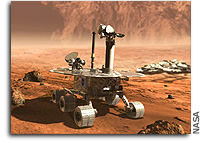Rehearsal Readies Scientists for NASA’s Next Mars Landing
 With less than a year to go before the launch of NASA’s Mars Exploration
With less than a year to go before the launch of NASA’s Mars Exploration
Rover mission, scientists have spent the last few weeks at a high-tech summer
camp, rehearsing their roles for when the spacecraft take center stage.
“The purpose of this test is really to teach the science team how to
remotely conduct field geology using a rover, rather than to test the rover
hardware,” said Dr. John Callas, science manager for the Mars Exploration
Rover mission at NASA’s Jet Propulsion Laboratory, Pasadena, Calif. “We sent
one of our engineering development rovers out to a distant, undisclosed desert
location, with the science team back at JPL planning the operations and sending
commands, just as they’ll do when the actual rovers are on Mars.”
The 10-day blind test, which ran from Aug. 10 to 19, used the Field
Integrated Design Operations testbed, called Fido, which is similar in size and
capability to the Mars Exploration Rovers. Although important differences
exist, the similarities are great enough that the same types of challenges
exist in commanding these rovers in complex realistic terrain as are expected
for the rovers on Mars.
“The scientific instruments on this test rover are similar to the Athena
science payload that will be carried by the Mars Exploration Rovers,” said Dr.
Steve Squyres, principal investigator for the Mars Exploration Rover mission at
Cornell University, Ithaca, N.Y. “We’re using the test rover now to learn how
to do good field geology with a robot. When we get to real Mars rover
operations in 2004, we’ll be able to use everything we’re learning now to
maximize our science return.”
“The test rover has received and executed daily commands via satellite
communications between JPL and the remote desert field site. Each day, they
have sent images and science data to JPL that reveal properties of the desert
geology,” said Dr. Eddie Tunstel, the rover’s lead engineer at JPL.
The Mars Exploration Rovers will be launched in May and June 2003. Upon
their arrival at Mars in January 2004, they will spend at least three months
conducting surface operations, exploring Mars for evidence of past water
interaction with the surface and looking for other clues to the planet’s past.
The science team of more than 60 scientists from around the world will
tell the rovers what to do and where to go from the mission control room at
JPL. This month’s test is one of several training operations that are planned
before landing.
The rovers are currently being built at JPL and will be shipped to the
Kennedy Space Center in Florida early next year to begin preparations for
launch. Shortly before the launch, NASA will select the landing sites.
More information about the rover mission is available at
http://www.jpl.nasa.gov/news/fact_sheets/mars03rovers.pdf or
http://mars.jpl.nasa.gov/mer .
A description of the Fido rover is available at
http://mars.jpl.nasa.gov/mer/fido
or
More information about the Mars Exploration Program is available at
http://mars.jpl.nasa.gov .
The Mars Exploration Rover mission is managed by JPL for NASA’s Office of
Space Science, Washington, D.C. JPL is a division of the California Institute
of Technology in Pasadena.
#####
NOTE TO EDITORS: A video file featuring b-roll of JPL mission control and the
field site and interviews is being broadcast on NASA TV today at 9 a.m., noon,
3 p.m. and 6 p.m. Pacific time. NASA TV is broadcast on GE-2, transponder 9C,
C-Band, located at 85 degrees West longitude. The frequency is 3880.0 MHz.
Polarization is vertical and audio is monaural at 6.8 MHz. More information
on NASA TV and a full programming schedule can be found at









